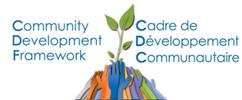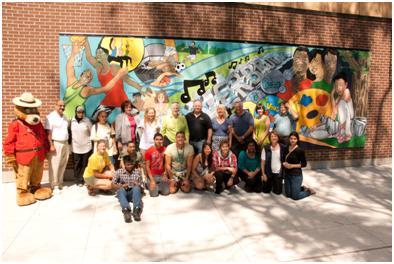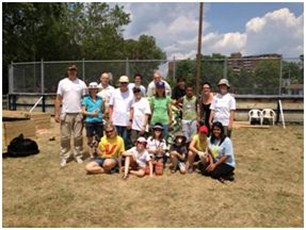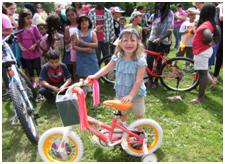
The Community Development Framework
The Community Development Framework (CDF) is a way to develop community that focuses on neighbourhoods. It brings together residents, community organizations, funders, researchers, and city services to build strong neighbourhoods.
The Community Development Framework has recently developed these Guiding Principals that describe community development practice within the Ottawa coalition of community health and resource centres. Click here to read more about the four core principles that define the work of CD and the evidence and framework that defines them.
CDF will help a neighbourhood:
- Decide on its goals and the changes it wants to make
- Achieve the neighbourhood's goals by having residents, institutions, community agencies, and other stakeholders working together
- Develop the skills and support to make the changes happen

How does the CDF work?
Across priority neighbourhoods[i] in Ottawa:
It starts with the people who live and work in the neighbourhood. They get together to work on local concerns that matter to them.
- Residents and community partners identify the neighbourhood's assets and needs using tools such as a neighbourhood survey or discussion groups
- Residents and partners make a plan to address concerns and then they put the plan into action.
- Community agencies and institutions identify possible partners, resources. Resources may come from the neighbourhood, the city, or the province. Community agencies and institutions help respond to the neighbourhood concerns that require change at a level beyond the neighbourhood (example: access to affordable, nutritious food).
- Residents and partners evaluate what worked well and what needs to be improved.
- Residents and partners make changes and keep going.
- CDF provides ways for residents and service providers to share knowledge and skills about how best to make change that will improve the neighbourhood.
- CDF supports neighbourhoods to celebrate their accomplishments to improve their neighbourhoods.
- Change happens when people work together!

How did CDF get started and how is it organized?
This community organizing approach builds on the success of the No Communities Left Behind (NCLB) initiative, whose guiding principles are: collaboration, coordination, community participation, and leveraging resources. The City of Ottawa took the lead in promoting this approach by bringing together partners, providing resources and helping to develop a structure. See timeline and archives for more information
Starting in 2008 CDF was piloted in four more neighbourhoods: Bayshore, Carlington, Centretown West, Overbrook.
In early 2012 the leadership and coordination of CDF shifted from the City of Ottawa to the Coalition of Community Health and Resource Centres (CHRCs) and the approach went city-wide
Steering table members include
How can I take part in my neighbourhood?
- Community development depends on people who live in the neighbourhood getting involved. Everybody can play a part.
- You can get involved in many different ways. For example, you can bring together people who are interested in the same things as you are. You can take part in a neighbourhood activity or volunteer at a community event.
- You can use your skills on a project (for example, plant a garden, baby-sit, deliver posters, or make some phone calls).
- Find out more by calling your local community health or resource centre


[i] Priority neighbourhoods are areas that would benefit from the approach, due to indicators of vulnerability. Indicators of vulnerability include Ottawa Neighbourhood Study information on socio-economic status, health, school readiness, and demographics. Rural geographical considerations, crime statistics and other relevant data/sources are also considered.
-
Get everyone involved
-
Encourage working together
-
Facilitate learning
-
Encourage leadership
-
Build on strengths
-
Leverage resources
-
Recognize complexity
-
Build relationships that will last
-
Plan for the future
-
Celebrate success